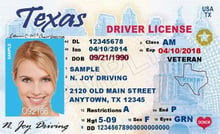If you live in Texas, you already know it’s big, with an area of 268,596 square miles. If Texas were a country, it would be the 40th largest country on earth, larger than any European country. The state operates the largest highway and rail networks in the country. But to use all those highways to get around the state on your own, you’ll need to obtain a Texas driver’s license.
In Texas, if you’re under 18, you must obtain an instruction permit (learner license) before applying for a driver’s license. The permit will allow you to practice driving under supervision. To obtain a permit in Texas, you must meet a whole series of requirements. One of the most crucial requirements is to pass a written knowledge exam on driving theory. (However, this exam may be waived if you’ve completed an approved driver education course.)
If you’re 18 or older, you must also pass the knowledge exam, but you won’t apply for a permit. Instead, you’ll apply directly for a driver’s license. However, the license will initially have the same restrictions as the instructional permit (learner license) issued to teen drivers. The Texas DMV written driving test has 30 multiple-choice questions based on the official driver’s manual (Texas DMV Handbook (TX Driver's Manual) 2026).















